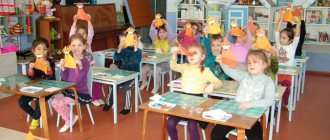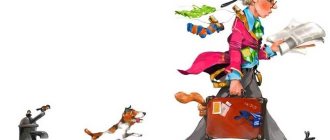On the topic: methodological developments, presentations and notes
Plan of drawing notes (preparatory group) on the topic: “Winter Landscape” using the non-traditional “Imprint” technique (drawing with vegetables).
Program content: Learn to draw rowan, highlighting the characteristic features of the bunch. Reinforce the idea of the color red; cultivate interest in collective creativity. Continue learning doat.
MBDOU "CRR - kindergarten "Bell" Summary of direct educational activities in drawing in the 1st junior group "Winnie the Pooh" Topic: "Wheels for the train" (non-trad.
summary of a drawing lesson in the junior group “Beasts in the Forest.”
Drawing outline for Cosmonaut Day using non-traditional drawing techniques.
Source
Summary of a drawing lesson in the senior group “Decorating boots”
Description of material:
The outline of a drawing lesson in the senior group is aimed at developing cooperation skills in children through productive activities.
Designed for preschool teachers. Goal:
expanding and consolidating ideas about shoes.
Objectives:
1. Expand and concretize ideas about shoes, their purpose, the details of which they consist.
2. Learn to group shoes according to seasonality. 3. Develop an aesthetic interest in shoe design. 4. Develop the skill of partner communication and mutual assistance in solving a common problem. 5. Cultivate respect for the partner in joint activities. Equipment, demonstration material:
cards with shoes, images of rubber boots, paints, boot template, white paper.
Preliminary work:
introduction to the profession of fashion designer, decoration of various clothes.
Progress of the lesson
Educator
: Today, near the kindergarten, I met the sun, which came to visit us.
But the sun is not simple, but magical. Whoever takes it in his hands will become the most affectionate and kind child in the world. Let's check! (We pass the balloon - the sun, saying a kind word to each other). It's true, we have become the kindest and most affectionate. Educator:
Guys, the bright sun is shining outside and every day it’s getting warmer and warmer.
What time of year has come to us? Children:
Spring
Teacher:
Yes, spring, but remind me what other seasons there are?
Children:
Summer, autumn, winter.
Educator:
Do they wear different shoes at different times of the year?
Children: Yes Didactic game with cards “Arrange your shoes by season” Educator:
Guys, now we will divide into three teams.
Look, there are pictures on the tables for each team. These pictures depict the seasons. Questions for the teams: what time of year is in your picture? Nearby are cut-out pictures of “shoes”. Assignment: choose shoes for your season. Educator:
I see that all teams managed to complete the task.
Tell me guys, why do they wear rubber boots in the spring? Children:
Snow is melting, puddles, so as not to get wet, dirty, damp.
Educator:
You said everything correctly.
Have you seen that boots, like clothes, are decorated with various patterns and pictures? Children
: Yes
Educator:
Fashion designers come up with different patterns for boots, and then we buy the ones we like.
Let's see how rubber boots are decorated. (showing images of various boots) Educator:
Who liked which pattern?
Have you noticed that both the left and right have the same pattern? Is it better to have different patterns or the same ones? Why? (children's answers) Educator
: Now there is a fashion design competition called “Spring Boots”.
Why is it called that? What do fashion designers do? Children:
It’s a competition to see who has the most beautiful, interesting, unusual boots.
Educator:
Yes guys, they offer different models.
You and I are also good fashion designers and can decorate not only clothes, but also shoes. Do you want to take part in a fashion design competition? Children:
Yes
Educator:
Then let's get to work so that we have time to send photographs of our work.
Choose a partner to create boots and sit down together. (children sit in pairs at tables) Educator:
Look, I have prepared white boots for you to decorate.
Make it bright and unusual so that people like them and buy them. (children sort out the templates) Educator:
I and other teachers have already prepared boots for the competition, look.
(showing examples) Educator:
First you need to agree on who you will make boots for, boys or girls.
What will you do after this? Children:
Let's discuss the pattern, select the right paints, and share brushes.
Educator: You said everything correctly, start discussing and drawing. Remember that the patterns on the right and left boots are the same. Work together and don't forget to ask for help if needed and help each other. (productive activity of children to the sound of cheerful spring music) Educator:
I see that many are finishing, I suggest putting the boots together.
We will look at them and take photos for the competition. (children put their boots on the common table) Educator:
Did you like doing the task?
How? Tell us how you did it? Educator:
Let's find a pair of boots with the same pattern.
Why do you think the pattern turned out the same, what did the guys do for it? Who had difficulties, what? How did you solve them? Educator:
You are great! We will definitely receive certificates for participating in the “Spring Boots” competition. Now I will take pictures and send our work.
Summary of educational activities on subject drawing for children 5–6 years old with mental retardation “Rubber boots”
Tatiana Kulagina
Summary of educational activities on subject drawing for children 5–6 years old with mental retardation “Rubber boots”
-Systematize children’s knowledge about seasonal clothing and shoes.
— To develop children’s in visual arts,
— Develop aesthetic perception of household items ,
— Cultivate goodwill when assessing the work of comrades, develop emotional responsiveness;
-Develop a caring attitude towards shoes.
-activation of the dictionary on the lexical topic “Clothing. Hats. Footwear: Autumn, it’s raining, rubber boots , leather boots , shoes, house slippers;
-enrichment of vocabulary: introduce children to the concept of “pair of shoes”
2. Preliminary work:
Examination of illustrations: Autumn, Clothes, Shoes, Hats;
Observing the weather in the kindergarten area, observing changes in the clothing of children and adults .
Didactic games: “Collect a picture”
,
“Dress the doll for a walk”
;
“Make clothes from parts”
; Different types of lacing.
Printed board game “Loto. Cloth. Shoes. Hats"
;
V. Stepanov “The ABC of the Seasons”
Poems and stories about autumn
S. Mikhalkov “Masha the Confused”
E. Blaginina “How smartly you are dressed.” Watching cartoons and educational films about shoes.
3.Materials and equipment:
- sippy cups with water,
- brushes of two sizes,
4. Scenario of an educational situation.
1. Introduction to the game situation (elements of psycho-gymnastics)
:
-Children, what time of year is it now?
Walk in boots . We will go for a walk in rainy weather in rubber boots We take off our boots , put them in a box and go to the tables.
Preview:
Municipal budgetary preschool educational institution
"Kindergarten of compensatory type No. 21"
Summary of direct educational activities for the implementation of the educational field
(in the older group for children with speech impairments)
drawing “Boots for spring”
Snezhinsk 2012-2013
In the educational field "Artistic Creativity"
- Learn to use 3 colors in your work (yellow, green, blue).
- To develop in children an idea of making a pattern using dyed threads.
- Learn to arrange pattern elements in accordance with the shape.
- Reinforce drawing techniques with thread.
- develop imagination and artistic taste.
In the educational field "Communication"
• Consolidate vocabulary on the topic “Shoes”
• Strengthen children's ability to answer questions in complete sentences.
• Learn to use plural nouns in the dative case in speech.
In the educational field "Socialization"
• Foster respect for shoes
In the educational field "Cognition"
• Strengthen children's knowledge about shoes
• Develop fine motor skills of the hands.
In the educational field "Health"
• Preserve and strengthen the physical and mental health of children using finger exercises.
In the educational field "Physical culture"
• Develop dexterity and eye when playing with the ball
Integrative qualities of children: to develop curiosity, mental and speech activity, independence, proficiency in dialogical speech, and the ability to manage their behavior.
Methods and techniques Tape recording, examination of illustrations, Didactic game “Brave Tailor” Didactic game “Multi-colored threads”, analysis and display of a sample, finger gymnastics, exhibition of works.
Health-saving technologies: finger gymnastics (Sudzhok balls)
Individual work: Vanya, Artem - help with choosing paint colors
Differentiated approach: for 1 subgroup. – offer 2 colors
Source
Techniques and techniques used within the framework of the topic “Clothing and footwear”
Drawing wardrobe items awakens children's interest in modeling, introduces them to the history of the emergence and development of both modern and ethnic costumes, helps them understand the stylistic features of types of clothing intended for different life situations, and introduces them to professions that are directly related to the creation of clothes and shoes. . Working on the decorative decoration of paper clothing has a beneficial effect on the development of creative abilities, fine motor skills, imagination and fantasy, attention and memory, abstract and spatial thinking.
Classic techniques:
- Drawing with a simple pencil.
- Drawing with colored pencils.
- Drawing with wax crayons.
- Drawing with felt-tip pens.
- Combined method (colored pencils and watercolors, felt-tip pens or wax crayons)
- Painting with a brush using gouache - a feature of this material is its covering ability due to its opacity property.
- Painting with a brush using watercolors. Children need to be taught the skills of regulating paint set, selecting colors, and softly conveying shades by mixing primary colors.
Non-traditional techniques:
- Finger drawing - drawing dots, rhythmic strokes, spirals, stripes and other decorative elements with your fingers.
- Palm painting - based on children's handprints. Six-year-old children apply paint to their palm with a brush themselves, then complete the contours of the object.
- Drawing using rock salt, semolina, colored sand - glue is applied to the base in the form of a fancy pattern, sprinkled with semolina or salt, the rest of the material is shaken off. The resulting three-dimensional image can be painted with paints.
- Stamping - quick tinting of the background, stencil drawing or depiction of decorative elements by applying an imprint on paper with stamps (shapes cut out on the surface of a cut potato, a piece of foam rubber).
- Threadography - laying out a silhouette with finely chopped threads.
- Spray - paint is applied to a wide, hard brush or toothbrush, then shaken onto paper using a thin stick, creating the effect of scattered drops.
- Bleeding drawing - an image is drawn with wax crayons on white paper, then painted over with a top layer of watercolor in one or more color shades.
Works in non-traditional techniques (photo gallery)
Work in the nitcography technique Work in the nitcography technique Work in the nitcography technique Work in the nitcography technique Work in the nitcography technique Postcard decorated in the palm technique Works in the plastinography technique Decorative elements made in the plastinography technique Works made in the salt drawing technique Drawing with millet additional painting Works using the technique of stamping a stencil blank and drawing with cotton swabs Works using the stamping technique Works using the spraying technique with elements of quilling and trimming
Drawing techniques for older preschoolers
Older preschoolers are actively improving their drawing techniques with pencils, crayons and felt-tip pens, since shading promotes the development of fine motor skills and coordination of movements, and therefore helps prepare children’s hands for writing.
- Line - can be of different lengths and rhythms and is the basic element of the pattern.
- Hatching is a simple way to fill in a contour drawing. Types of shading:
- Chaotic - the strokes are laid in a free direction, then they are formed by additional contour drawing of the outlines of the object.
- Vertical - dense strokes are applied in a vertical direction. Using colored pencils with different pressure levels will allow you to get the effect of a smooth change of various shades.
- Diagonal - applying strokes at different angles.
- Horizontal - requires changing the usual position of the hand in the process of coloring.
- Dot, rhythmic stroke, brush stroke using the technique of painting with watercolors and gouache paints.
Samples and step-by-step description of the work procedure
“Snowflake on a mitten” - work using the technique of a developing pattern with appliqué elements
Materials: blank mitten silhouette, wax crayons, gouache, watercolor paints, scissors, white paper.
Instructions:
- Cut out the silhouette of a mitten from white paper according to the template.
- Draw a pattern with wax chalk.
- Paint the mitten with watercolors. Use cotton swabs to draw decorative dots. Using a stencil, cut out a snowflake.
- Tint the album sheet with blue gouache, glue on the mitten, and use cotton swabs to decorate the snowflakes.
“Mitten for Mommy” - decorative drawing with elements of non-traditional techniques (stamps and cotton swabs)
Materials: gouache, cotton swabs, potato stamps with cut out geometric elements, mitten silhouette blanks tinted with red gouache, brushes, gouache.
Learning task: design a pair of mittens with the same pattern on each. Children work in pairs based on free design, discussing the drawing with each other; the teacher's example is used to explain the task, and not to copy the pattern.
Instructions:
- Children agree on the sequence of work and the techniques they will use. You can start by drawing geometric elements using a potato stamp.
- The girls decided to draw a beautiful flower.
- The boys started by drawing a line separating the edge and shaping the fur using cotton swabs. If necessary, the teacher helps with hints and advice.
- After the end of the creative stage of the lesson, the children lay out the mittens on the table, compare the similarities and differences, the teacher discusses successful drawings with the children, helps to understand the reasons for the mistakes that prevented them from completing the task well.
“Painting an outfit in ethnic style” - decorative painting in gouache based on Gzhel and Dymkovo ornaments
Instructions: Children choose cut out figures and decorate them with elements of decorative patterns of a traditional toy.
Children's works (photo gallery)
Painting in the style of the Dymkovo ornament Painting in the style of the Dymkovo ornament Painting in the style of the Dymkovo ornament
“Types of shoes” - coloring with colored pencils and felt-tip pens
Learning objective: to develop design abilities and independent work skills.
Instructions:
Children independently choose a contour image of a certain type of shoe and design it at their own discretion (paint it, decorate it with decorative patterns).
Children's work on the topic “Types of shoes” (photo gallery)
Drawing with colored pencils with a drawing of a geometric pattern Drawing with colored pencils with a drawing of a pattern Drawing with colored pencils Drawing with colored pencils with a drawing of a floral ornament Drawing with a colored pencil Drawing with colored pencils Drawing with colored pencils with a drawing of a geometric pattern Drawing with a colored pencil Drawing with colored pencils
“House of Models” – painting with watercolors
Instructions:
Children trace the silhouettes of clothing items with a simple pencil and paint them with watercolors, independently thinking through the design (stripes, dots, curls, flowers, etc.).
Technological maps for designs of clothing, shoes and hats
The reference lines for clothing designs are straight lines intersecting at an angle and resembling letters.
Table: drawing diagrams of wardrobe elements for older preschoolers
| Theme of the drawing | Description |
| "Summer Wardrobe" | T-shirt
Shorts
Dress (blouse)
|
| "Cap" |
|
| "Dress for a doll" |
|
Photo gallery: samples of clothing patterns
If you make the dress shorter, you get a blouse, and if you lengthen the shorts, you get trousers
To draw woolen items you need to make soft transitions of elements
This dress is drawn based on a vertical line in the center of the image.
Photo gallery: templates for decorating and coloring clothes
Children can choose their own pattern for coloring the shirt
An additional task for coloring a dress can be a selection of decorative elements
Children with mental retardation can be given the task of coloring their skirt in a certain color, trying not to go beyond the boundaries of the image.
Based on this coloring book, children can come up with stories about where they have been and what fairy shoes they have seen.
You can use wax crayons to color the mittens.
While coloring a straw hat, children practice different types of shading
Video: master class on drawing winter hats
Video: master class on drawing shoes
Video: master class on drawing an elegant dress for a doll
Video: master class on drawing and painting a national costume
Drawing clothes, hats and shoes in the senior group gives children initial ideas about modeling wardrobe items and teaches them how to create original prints based on geometric patterns. Children improve their visual skills, practice the ability to use a brush and pencils to create images of varying degrees of color intensity, and expand their knowledge of the history of national costume. In addition, templates for drawing clothes are used in working with children with mental retardation.




